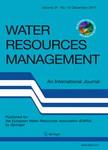版权所有:内蒙古大学图书馆 技术提供:维普资讯• 智图
内蒙古自治区呼和浩特市赛罕区大学西街235号 邮编: 010021

作者机构:Politecn Torino Dipartimento Idraul Trasporti & Infrastrutture I-10129 Turin Italy Politecn Torino Dipartimento Territorio Ambiente & Geotecnol I-10129 Turin Italy Tech Univ Wien Inst Wasserbau & Ingn Hydrol A-1040 Vienna Austria
出 版 物:《WATER RESOURCES MANAGEMENT》 (水资源管理)
年 卷 期:2010年第24卷第14期
页 面:4049-4074页
核心收录:
学科分类:08[工学] 0815[工学-水利工程] 0814[工学-土木工程]
基 金:Regione Piemonte [CIPE 2004] CUBIST [MIUR-2007HBTS85]
主 题:Low flows Regionalization Regional regression Classification and regression tree CART
摘 要:Prediction of low flows in ungauged catchments is needed in many branches of water resources management, including water availability and river ecology studies. In this paper we analyze the regional variability of q (95), i.e., the specific discharge that is exceeded 95% of the time, in North-Western Italy (Piemonte and Valle d Aosta Regions). Multiple regressions with morphoclimatic catchment characteristics are applied in subregions obtained through four classification methods: Seasonality Indices (SI), Classification and Regression Trees (CRT), Residual Pattern Approach (RPA) and Weighted Cluster Analysis (WCA). All the classification methods separate the South-Eastern Apennine-Mediterranean area from the rest of the study domain (the Alps mountain range), even if they use different criteria to carry out this division (e.g., the percentage of forest, seasonality of low flows, combination of several parameters). In the Apennine-Mediterranean part of the area, low flows occur in summer with a long period of drought and are mainly due to dry climate, moderate snowpack storage and high evapotranspiration. In Alpine catchments low flows occur in winter and vary according to precipitation, elevation, interactions with aquifers and land cover. Within the Alpine mountain range the CRT algorithm identifies a number of small high-elevation catchments in which the intense drought period during winter has the soil freezing processes as the driving force. From a statistical point of view, the CRT model outperforms the models obtained by the other classification techniques in terms of explained variance (69%). Because of this, and given the meaningful hydrological interpretation of the results, we use the CRT model for the regionalization of q (95) in Piemonte and Valle d Aosta. Lastly, as operational procedure for future low flow regionalization studies, we suggest that more classification methods should be applied to assist the critical analysis of the results.